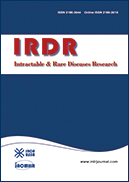Volume 6, Issue 2
Displaying 1-15 of 15 articles from this issue
- |<
- <
- 1
- >
- >|
Reviews
-
2017 Volume 6 Issue 2 Pages 80-86
Published: May 31, 2017
Released on J-STAGE: June 11, 2017
Advance online publication: April 30, 2017Download PDF (1272K) -
2017 Volume 6 Issue 2 Pages 87-94
Published: May 31, 2017
Released on J-STAGE: June 11, 2017
Advance online publication: April 16, 2017Download PDF (559K) -
2017 Volume 6 Issue 2 Pages 95-101
Published: May 31, 2017
Released on J-STAGE: June 11, 2017
Advance online publication: May 22, 2017Download PDF (458K)
Mini-Review
-
2017 Volume 6 Issue 2 Pages 102-105
Published: May 31, 2017
Released on J-STAGE: June 11, 2017
Advance online publication: May 28, 2017Download PDF (256K)
Original Article
-
2017 Volume 6 Issue 2 Pages 106-113
Published: May 31, 2017
Released on J-STAGE: June 11, 2017
Advance online publication: April 16, 2017Download PDF (357K)
Brief Reports
-
2017 Volume 6 Issue 2 Pages 114-118
Published: May 31, 2017
Released on J-STAGE: June 11, 2017
Advance online publication: May 22, 2017Download PDF (262K) -
2017 Volume 6 Issue 2 Pages 119-123
Published: May 31, 2017
Released on J-STAGE: June 11, 2017
Advance online publication: May 26, 2017Download PDF (523K)
Case Reports
-
2017 Volume 6 Issue 2 Pages 124-127
Published: May 31, 2017
Released on J-STAGE: June 11, 2017
Advance online publication: April 12, 2017Download PDF (920K) -
2017 Volume 6 Issue 2 Pages 128-131
Published: May 31, 2017
Released on J-STAGE: June 11, 2017
Advance online publication: April 30, 2017Download PDF (1109K) -
2017 Volume 6 Issue 2 Pages 132-136
Published: May 31, 2017
Released on J-STAGE: June 11, 2017
Advance online publication: May 24, 2017Download PDF (848K) -
2017 Volume 6 Issue 2 Pages 137-140
Published: May 31, 2017
Released on J-STAGE: June 11, 2017
Advance online publication: May 24, 2017Download PDF (381K) -
2017 Volume 6 Issue 2 Pages 141-144
Published: May 31, 2017
Released on J-STAGE: June 11, 2017
Advance online publication: April 16, 2017Download PDF (349K) -
2017 Volume 6 Issue 2 Pages 145-147
Published: May 31, 2017
Released on J-STAGE: June 11, 2017
Advance online publication: May 22, 2017Download PDF (638K)
Commentary
-
2017 Volume 6 Issue 2 Pages 148-149
Published: May 31, 2017
Released on J-STAGE: June 11, 2017
Advance online publication: April 16, 2017Download PDF (172K)
Letter
-
2017 Volume 6 Issue 2 Pages 150-151
Published: May 31, 2017
Released on J-STAGE: June 11, 2017
Advance online publication: April 30, 2017Download PDF (330K)
- |<
- <
- 1
- >
- >|
